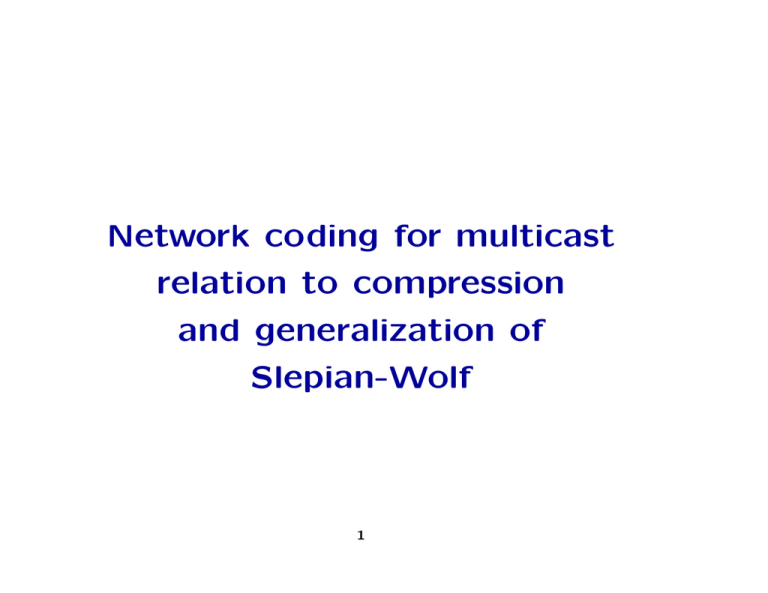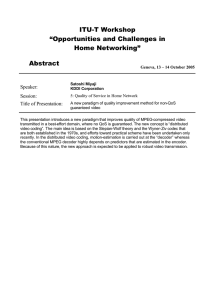Network relation and Slepian-Wolf
advertisement

Network coding for multicast
relation to compression
and generalization of
Slepian-Wolf
1
Overview
• Review of Slepian-Wolf
• Distributed network compression
• Error exponents Source-channel separation issues
• Code construction for finite field multiple access networks
2
Distributed data compression
Consider two correlated sources (X, Y ) ∼ p(x, y) that must be
separately encoded for a user who wants to reconstruct both
What information transmission rates from each source allow de­
coding with arbitrarily small probability of error?
E.g.
H(X1)
X1
..
X2
..
H(X2| X1)
3
Distributed source code
A ((2nR1 , 2nR2 ), n) distributed source code for joint source (X, Y )
consists of encoder maps
f1 : X n → {1, 2, . . . , 2nR1 }
f2 : Y n → {1, 2, . . . , 2nR2 }
and a decoder map
g : {1, 2, . . . , 2nR1 } × {1, 2, . . . , 2nR2 } → X n × Y n
- X n is mapped to f1(X n)
- Y n is mapped to f2(Y n)
- (R1, R2) is the rate pair of the code
4
Probability of error
(n)
Pe
= Pr{g(f1(X n), f2(Y n)) = (X n, Y n)}
Slepian-Wolf
Definitions:
A rate pair (R1, R2) is achievable if there exists a sequence of
((2nR1 , 2nR2 ), n) distributed source codes with probability of error
(n)
Pe → 0 as n → ∞
achievable rate region - closure of the set of achievable rates
Slepian-Wolf Theorem:
5
For the distributed source coding problem for source (X, Y )
drawn i.i.d. ∼ p(x, y), the achievable rate region is
R1 ≥ H(X|Y )
R2 ≥ H(Y |X)
R1 + R2 ≥ H(X, Y )
Proof of achievability
Main idea: show that if the rate pair is in the Slepian-Wolf region,
we can use a random binning encoding scheme with typical set
decoding to obtain a probability of error that tends to zero
Coding scheme:
• Source X assigns every sourceword x ∈ X n randomly among
2nR1 bins, and source Y independently assigns every y ∈ Y n
randomly among 2nR2 bins
• Each sends the bin index corresponding to the message
6
• the receiver decodes correctly if there is exactly one jointly
typical sourceword pair corresponding to the received bin in­
dexes, otherwise it declares an error
Random binning for single source compression
An encoder that knows the typical set can compress a source X
to H(X)+ without loss, by employing separate codes for typical
and atypical sequences
Random binning is a way to compress a source X to H(X) + with asymptotically small probability of error without the encoder
knowing the typical set, as well as the decoder knows the typical
set
• the encoder maps each source sequence X n uniformly at ran­
dom into one of 2nR bins
7
• the bin index, which is R bits long, forms the code
• the receiver decodes correctly if there is exactly one typical
sequence corresponding to the received bin index
Error analysis
An error occurs if:
a) the transmitted sourceword is not typical, i.e. event
(n)
E0 = {X ∈
/ A
}
b) there exists another typical sourceword in the same bin, i.e.event
(n)
E1 = {∃x =
X : f (x) = f (X), x ∈ A
Use union of events bound:
(n)
Pe
= Pr(E0 ∪ E1)
≤ Pr(E0) + Pr(E1)
8
}
Error analysis continued
Pr(E0) → 0 by the Asymptotic Equipartition Property (AEP)
Pr(E1) =
≤
=
≤
x
x
Pr{∃x =
x : f (x) = f (x),
x ∈ A(n)
}
Pr(f (x) = f (x))
x� = x
x� ∈ A(n)
(n)
|A
| 2−nR
x
2−nR 2n(H(X)+)
→ 0 if R > H(X)
9
For sufficiently large n,
Pr(E0), Pr(E1) < (n)
⇒ P
< 2
Jointly typical sequences
(n)
The set A of jointly typical sequences is the set of sequences
(x, y) ∈ X n × Y n with probability:
2−n(H(X)+) ≤ pX (x) ≤ 2−n(H(X)−)
2−n(H(Y )+) ≤ pY (y) ≤ 2−n(H(Y )−)
2−n(H(X,Y )+) ≤ pX,Y (x, y) ≤ 2−n(H(X,Y )−)
for (X, Y) sequences of length n IID according to pX,Y (x, y) =
n
i=1 pX,Y (xi , yi )
Size of typical set:
(n)
|A
| ≤ 2n(H(X,Y )+)
10
Proof:
1 =
≥
p(x, y)
p(x, y)
(n)
A
(n)
≥ |A
|2−n(H(X,Y )+)
Conditionally typical sequences
(n)
The conditionally typical set A (X|y) for a given typical y se­
quence is the set of x sequences that are jointly typical with the
given y sequence.
Size of conditionally typical set:
(n)
|A
(X|y)| ≤ 2n(H(X|Y )+)
Proof:
11
(n)
For (x, y) ∈ A
(X, Y ),
.
p(y) = 2−n(H(Y )±)
.
p(x, y) = 2−n(H(X,Y )±)
p(x, y)
⇒ p(x|y) =
p(y)
.
= 2−n(H(X|Y )±2)
Hence
1 ≥
p(x|y)
x∈A(n)
(X|y)
(n)
≥ |A |2−n(H(X|Y )+2)
Proof of achievability – error analysis
Errors occur if:
a) the transmitted sourcewords are not jointly typical, i.e. event
(n)
E0 = {(X, Y ) ∈
/ A
}
b) there exists another pair of jointly typical sourcewords in the
same pair of bins, i.e. one or more of the following events
(n)
X : f1(x) = f1(X), (x, Y) ∈ A }
E1 = {∃x =
(n)
Y : f2(y) = f2(Y), (X, y) ∈ A }
E2 = {∃y =
E12 = {∃(x, y) : x = X, y = Y, f1(x) = f1(X),
(n)
f2(y) = f2(Y), (x, y) ∈ A }
12
Use union of events bound:
(n)
Pe
= Pr(E0 ∪ E1 ∪ E2 ∪ E12)
≤ Pr(E0) + Pr(E1) + Pr(E2) + Pr(E12)
Error analysis continued
Pr(E0) → 0 by the AEP Pr(E1) =
Pr{∃x = x : f1(x) = f1(x),
(x,y)
(n)
≤
(x,y)
=
≤
(x, y) ∈ A
}
Pr(f1(x) = f1(x))
x� = x
(x� , y) ∈ A(n)
(n)
|A
(X|y)| 2−nR1
(x,y)
2−nR1 2n(H(X|Y )+2)
→ 0 if R1 > H(X|Y )
13
Similarly,
Pr(E2) ≤ 2−nR2 2n(H(Y |X)+2)
→ 0 if R2 > H(Y |X)
Pr(E12) ≤ 2−n(R1+R2) 2n(H(X,Y )+)
→ 0 if R1 + R2 > H(X, Y )
Error analysis continued
Thus, if we are in the Slepian-Wolf rate region, for sufficiently
large n,
Pr(E0), Pr(E1), Pr(E2), Pr(E12) < (n)
⇒ P
< 4
Since the average probability of error is less than 4, there exist
at least one code (f1∗, f2∗, g ∗) with probability of error < 4.
(n)
Thus, there exists a sequence of codes with P
14
→ 0.
Model for distributed network compression
• arbitrary directed graph with integer capacity links
• discrete memoryless source processes with integer bit rates
• randomized linear network coding over vectors of bits in F2
• coefficients of overall combination transmitted to receivers
• receivers perform minimum entropy or maximum a posteriori
probability decoding
15
Distributed compression problem
Consider
• two sources of bit rates r1, r2, whose output values in each
unit time period are drawn i.i.d. from the same joint distri­
bution Q
• linear network coding in F2 over vectors of nr1 and nr2 bits
from each source respectively
Define
16
• m1 and m2 the minimum cut capacities between the receiver
and each source respectively
• m3 the minimum cut capacity between the receiver and both
sources
• L the maximum source-receiver path length
Theorem 1 The error probability at each receiver using mini­
mum entropy
or maximum a posteriori probability decoding is at
3
most i=1 pie, where
p1e ≤ exp
− n min
X1 ,X2
D(PX1 X2 ||Q)
+ 1
+ 22r1 +r2 log(n + 1)
+ m1 (1 − log L) − H(X1 |X2)
n
p2e ≤ exp
− n min
X1 ,X2
D(PX1 X2 ||Q)
+ 1
+ 2r1+2r2 log(n + 1)
+ m2 (1 − log L) − H(X2 |X1)
n
p3e ≤ exp
− n min
X1 ,X2
D(PX1 X2 ||Q)
+ 1
+ 22r1 +2r2 log(n + 1)
+ m3 (1 − log L) − H(X1 X2)
n
17
Distributed compression
• Redundancy is removed or added in different parts of the
network depending on available capacity
• Achieved without knowledge of source entropy rates at inte­
rior network nodes
• For the special case of a Slepian-Wolf source network con­
sisting of a link from each source to the receiver, the network
coding error exponents reduce to known error exponents for
linear Slepian-Wolf coding [Csi82]
18
Proof outline
i
• Error probability ≤
3
i
=1 pe
, where – p
1
e
is the probability of correctly decoding X2 but not X1 ,
– p
2
e
is the probability of correctly decoding X1 but not X2
– p
3
e
is the probability of wrongly decoding X1 , X2
• Proof approach using method of types similar to that in
[Csi82]
• Types Pxi , joint types Pxy are the empirical distributions of
elements in vectors xi
19
Proof outline (cont’d)
Bound error probabilities by summing over
• sets of joint types
⎧
⎪
{PX X˜ X X˜ | X˜1 =
X1, X˜2 = X2} i = 1
⎪
⎨
1 1 2 2
Pin = {PX1X˜1X2X˜2 | X˜1 = X1, X˜2 = X2} i = 2
⎪
⎪
⎩ {P
˜
˜ X2 } i = 3
X1 X˜1X2X˜2 | X1 = X1 , X2 =
˜i ∈ Fnri
where Xi, X
2
20
• sequences of each type
n(r1+r2) TX1X2 = [ x y ] ∈ F2
Pxy = PX1X2
n(r1+r2 ) TX˜ X˜ |X X (xy) = [ x̃ ỹ ] ∈ F2
1 2 1 2
Px̃yxy
= PX˜ X˜ X X
˜
1 2 1 2
Proof outline (cont’d)
• Define
– Pi, i = 1, 2, the probability that distinct (x, y), (x̃, y), where
x=
˜
x, at the receiver
– P3, the probability that (x, y), (˜
x, y
˜), where x = ˜
x,y =
y
˜,
are mapped to the same output at the receiver
• These probabilities can be calculated for a given network, or
bounded in terms of block length n and network parameters
21
Proof outline (cont’d)
• A link with ≥ 1 nonzero incoming signal carries the zero
signal with probability 21nc , where c is the link capacity
• this is equal to the probability that a pair of distinct input
values are mapped to the same output on the link
• We can show by induction on the minimum cut capacities mi
that
1 L mi
Pi ≤ 1 − (1 − n )
2
mi
L
≤
2n
22
Proof outline (cont’d)
We substitute in
• cardinality bounds
2
|P1
n| < (n + 1)
2
|P2
n| < (n + 1)
2r1 +r2
r1 +2r2
2r1 +2r2
2
|P3
n| < (n + 1)
|TX1X2 | ≤ exp{nH(X1X2)}
|TX˜ X˜ |X X (xy)| ≤ exp{nH(X˜1X˜2|X1X2)}
1 2 1 2
• probability of source vector of type (x, y) ∈ TX1X2
Qn(xy) = exp{−n(D(PX1X2 ||Q) + H(X1X2))}
23
Proof outline (cont’d)
and the decoding conditions
• minimum entropy decoder:
H(X˜1X˜2) ≤ H(X1X2)
• maximum a posteriori probability decoder:
D(PX˜ X˜ ||Q) + H(X˜1X˜2) ≤ D(PX1X2 ||Q) + H(X1X2)
1 2
to obtain the result
24
Conclusions
• Distributed randomized network coding can achieve distributed
compression of correlated sources
• Error exponents generalize results for linear Slepian Wolf cod­
ing
• Further work: investigation of non-uniform code distribu­
tions, other types of codes, and other decoding schemes
25
MIT OpenCourseWare
http://ocw.mit.edu
6.441 Information Theory
Spring 2010
For information about citing these materials or our Terms of Use, visit: http://ocw.mit.edu/terms.
